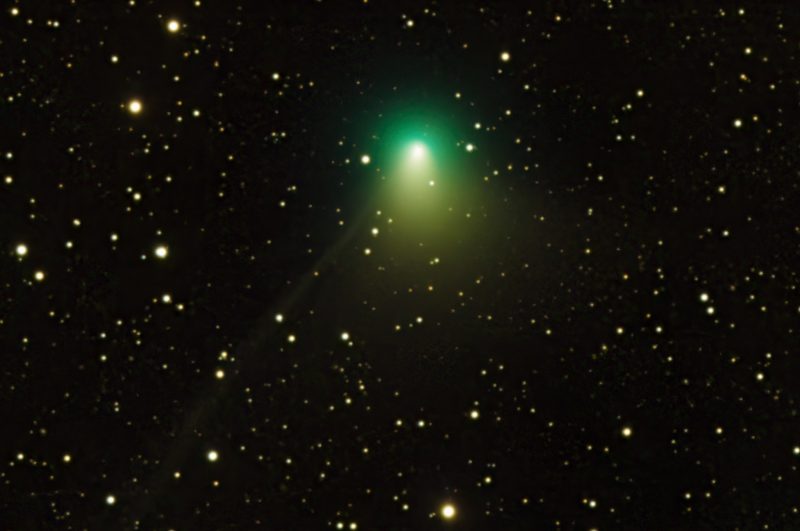
Don Machholz wrote this article for EarthSky in March 2022. Sadly, Don passed away from Covid-19 on August 9, 2022. If you would like to support his family in their time of need, this is a link to his GoFundMe. Recent updates on this article are by Eddie Irizarry and editors at EarthSky.
Comet 2022 E3 ZTF nearing perihelion
Comet C/2022 E3 (ZTF) will reach perihelion, its closest point to the sun, on January 12, 2023. At perihelion, the comet will be 1.11 astronomical units (AU) from the sun. Then, on February 2, 2023, the comet will reach its closest point to the Earth, at a distance of 0.29 AU or 27 million miles (44 million km) away. So January and February are prime times to view this fuzzy, icy visitor from the outer solar system.
Right now, the comet is in the direction of the constellation Corona Borealis, the Northern Crown. Its northern location means you’ll have to be in the Northern Hemisphere to spot it. The current estimate of the comet’s brightness is at magnitude 7.4, so you’ll still need optical aid to see it. But if it continues to brighten as it has, it could be magnitude 5 or 6, in the realm of unaided eyes from a dark-sky site, by the end of the month.
As you can see from the light curve chart at astro.vanbuitenen, the comet has pretty much followed the predicted curve as it brightens and enters the inner solar system. The website is predicting the comet to shine at magnitude 6.8 at perihelion and magnitude 5 at its closest approach to Earth in the beginning of February.
How comet C/2022 E3 (ZTF) got its name
Astronomers discovered the comet using the 48-inch (1.2-meter) Samuel Oschin robotic telescope, part of the Zwicky Transient Facility (ZTF), located at Mt. Palomar in southern California. They discovered it on March 2, 2022, and it was the third such object discovered in the fifth half-month (A, B, C, D, E) of the year. Thus, 2022 E3 ZTF.
How to see the comet
Currently, Comet 2022 E3 has moved into the morning sky for Northern Hemisphere observers. You’ll have to stay up past midnight or get up before dawn to spot it. It’s now in Corona Borealis, heading toward the north celestial pole and Polaris. Later, it will be in the general vicinity of Polaris on January 30. Hopefully by then, it will be visible to the unaided eye. As it heads closer to Polaris, it will become visible earlier in the evening. Use our finder charts below to help locate it in your skies.
At perihelion on January 12, look low on the northeastern horizon just before midnight. The comet will be rising between Boötes and Hercules.
Overall finder maps for comet 2022 E3 ZTF

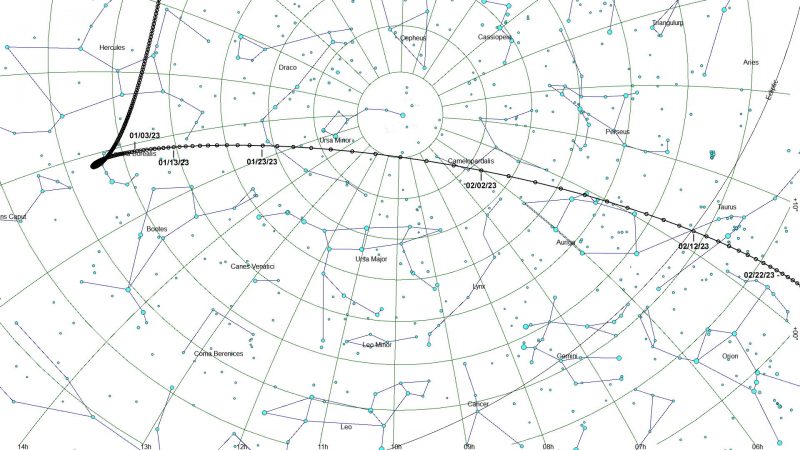
Date-specific finder maps for comet 2022 E3 ZTF
Comet 2022 E3 ZTF will be at perihelion, or closest to the sun, on January 12, 2023. Then, on February 1, 2023, comet C/2022 E3 (ZTF) will pass Earth at a very safe distance of more than 26 million miles (42 million km).





The comet and Mars
If it’s your first attempt to locate a comet, try on February 10, 2023, when the comet appears extremely close to Mars. Sky enthusiasts as well as casual photographers can try to capture images of this comet by pointing a camera toward its approximate location in the sky and taking long-exposure photos of 20 to 30 seconds. The images may reveal a fuzzy, tailed object. Using this technique, many have been able to photograph a comet even if they don’t see it visually.

Good geometry
Comet C/2022 E3 (ZTF) has favorable geometry with respect to Earth. Normally, a comet will pass near the sun’s vicinity, and the elongation, which is the angle in degrees between the sun and the comet as seen from Earth, grows small and the comet disappears in the sun’s glare for a few weeks. Not this one! In contrast, it stays in the dark sky for most of its trip through the inner solar system.
Moreover, the tilt of the orbit to our path around the sun is steep and retrograde, meaning the comet goes around the sun in the opposite direction than do the planets. This means it will, at some point, move quickly through our sky.
The comet entered our solar system from the north, and on February 12, 2023, passes to the south of our orbital plane.
Northern Hemisphere observers will have a view of the comet until the end of April 2023, when the comet, then a telescopic object, will disappear into the evening twilight.
Southern Hemisphere observers, however, lost their view of the comet in early October 2022. It disappeared into evening twilight as it rapidly headed northward. Their next view of the comet will come in early February 2023, when it pops above their northern horizon.
The discovery story
Comet C/2022 E3 (ZTF) was in the morning sky, in the direction of the constellation Aquila the Eagle, when astronomers with the Zwicky Transient Facility first spotted it.
The ZTF program images the whole Northern Hemisphere every two nights looking for supernovae, variable stars, binary stars, flashing merging neutron stars, asteroids and comets. Overall, it has discovered 10 comets in the past three years, and half of them carry the acronym ZTF in their names. One, discovered a year ago, was named C/2021 E3 (ZTF). Similar name, to be sure, but don’t confuse the two comets. Today, we are talking about the 2022 one!
At its March 2022 discovery, this comet had a very faint 17th magnitude brightness. Initially, it appeared as a stellar object, that is, as a dimly shining point. But, unlike the stars, whose distances make their motions undetectable except via special techniques, this object was moving in front of the stars.
Interesting #comet confirmed:
C/2022 E3 (ZTF)
After perihelion on Jan 13, 2023 it approaches earth to 0.29 AU on Feb 2. By then it may be brighter than magnitude 6 while conveniently located for N. hemisphere observers in Camelopardalis.
MPEC 2022-F13 and https://t.co/a7m73XRPFh pic.twitter.com/MDEuGcGxNd— Gideon van Buitenen (@giddgvb) March 21, 2022
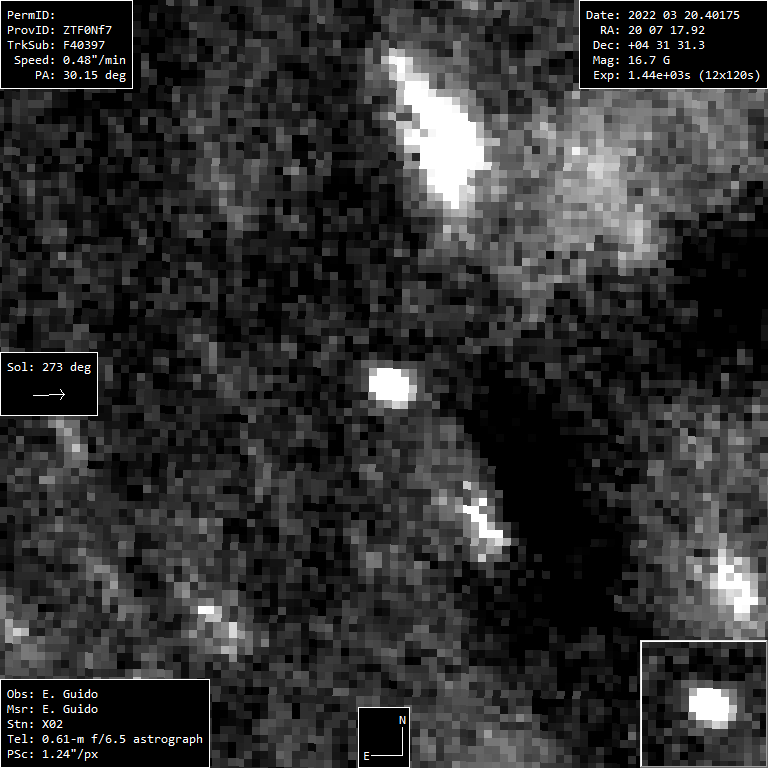
Confirming its cometary nature
Furthermore, newly discovered objects found to be moving go into the Minor Planet Center’s NEO Page. That’s how other astronomers know what to image and hopefully, thereby, confirm the object. As both professional and amateur astronomers do find the new object, they submit more positions for it to the Minor Planet Center. Then, scientists can determine a preliminary orbit. In this case, it originally looked more like a comet orbit than an asteroid’s orbit. That is, the path around the sun was oblong and not circular.
At that point, the object went on the Possible Comet Confirmation Page. Astronomers tried to image it to see if it had a coma or extended atmosphere surrounding the object’s nucleus or core. Why is that important? It’s important because virtually all asteroids – which tend to be rocky or metallic – appear starlike (the name asteroid means “starlike”) from Earth. But, an icy comet will form a halo, or coma, around its nucleus as the material on the nucleus heats up when the comet is moving inward toward the sun. Indeed, only several high-magnification images, stacked to increase contrast, will show the coma of a faint comet.
Three teams imaged this new object, and they did find a coma.
Photo gallery for E3 ZTF
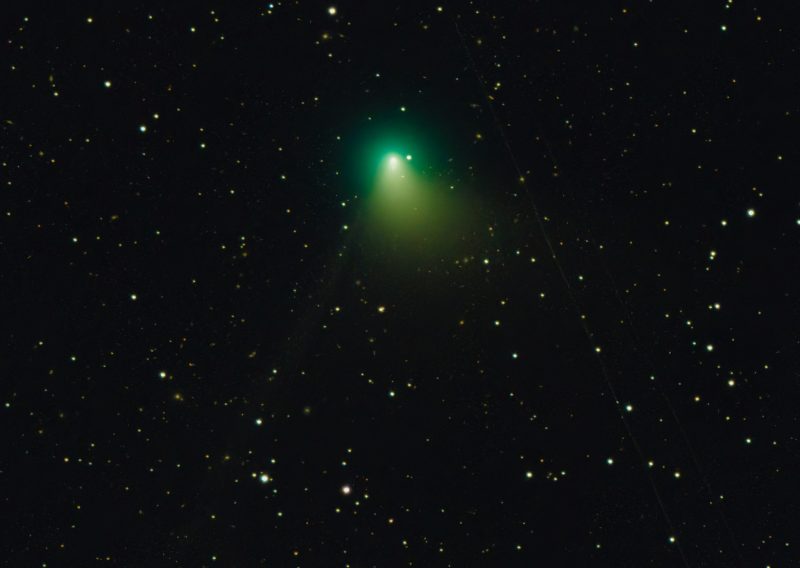
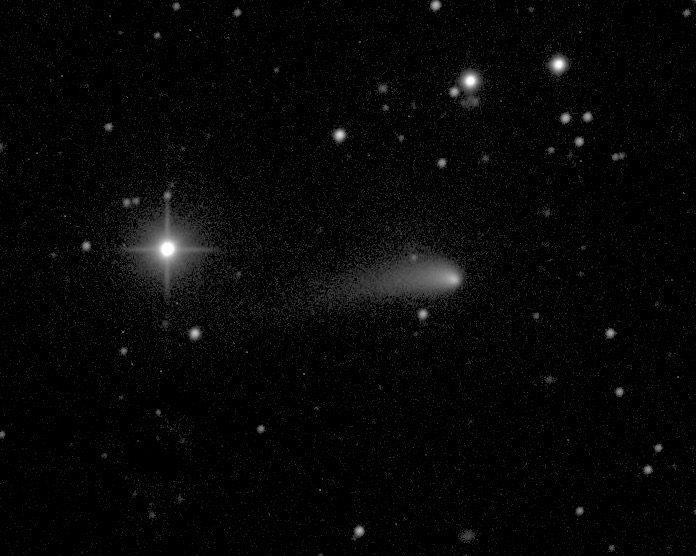
Bottom line: Comet 2022 E3 (ZTF) is nearing its closest point to the sun, or perihelion. It may become visible to the unaided eye by the end of January.
Submit your comet images to EarthSky Community Photos.
The post Comet 2022 E3 ZTF nearing closest point to the sun first appeared on EarthSky.
from EarthSky https://ift.tt/xH3dlBE

Don Machholz wrote this article for EarthSky in March 2022. Sadly, Don passed away from Covid-19 on August 9, 2022. If you would like to support his family in their time of need, this is a link to his GoFundMe. Recent updates on this article are by Eddie Irizarry and editors at EarthSky.
Comet 2022 E3 ZTF nearing perihelion
Comet C/2022 E3 (ZTF) will reach perihelion, its closest point to the sun, on January 12, 2023. At perihelion, the comet will be 1.11 astronomical units (AU) from the sun. Then, on February 2, 2023, the comet will reach its closest point to the Earth, at a distance of 0.29 AU or 27 million miles (44 million km) away. So January and February are prime times to view this fuzzy, icy visitor from the outer solar system.
Right now, the comet is in the direction of the constellation Corona Borealis, the Northern Crown. Its northern location means you’ll have to be in the Northern Hemisphere to spot it. The current estimate of the comet’s brightness is at magnitude 7.4, so you’ll still need optical aid to see it. But if it continues to brighten as it has, it could be magnitude 5 or 6, in the realm of unaided eyes from a dark-sky site, by the end of the month.
As you can see from the light curve chart at astro.vanbuitenen, the comet has pretty much followed the predicted curve as it brightens and enters the inner solar system. The website is predicting the comet to shine at magnitude 6.8 at perihelion and magnitude 5 at its closest approach to Earth in the beginning of February.
How comet C/2022 E3 (ZTF) got its name
Astronomers discovered the comet using the 48-inch (1.2-meter) Samuel Oschin robotic telescope, part of the Zwicky Transient Facility (ZTF), located at Mt. Palomar in southern California. They discovered it on March 2, 2022, and it was the third such object discovered in the fifth half-month (A, B, C, D, E) of the year. Thus, 2022 E3 ZTF.
How to see the comet
Currently, Comet 2022 E3 has moved into the morning sky for Northern Hemisphere observers. You’ll have to stay up past midnight or get up before dawn to spot it. It’s now in Corona Borealis, heading toward the north celestial pole and Polaris. Later, it will be in the general vicinity of Polaris on January 30. Hopefully by then, it will be visible to the unaided eye. As it heads closer to Polaris, it will become visible earlier in the evening. Use our finder charts below to help locate it in your skies.
At perihelion on January 12, look low on the northeastern horizon just before midnight. The comet will be rising between Boötes and Hercules.
Overall finder maps for comet 2022 E3 ZTF


Date-specific finder maps for comet 2022 E3 ZTF
Comet 2022 E3 ZTF will be at perihelion, or closest to the sun, on January 12, 2023. Then, on February 1, 2023, comet C/2022 E3 (ZTF) will pass Earth at a very safe distance of more than 26 million miles (42 million km).





The comet and Mars
If it’s your first attempt to locate a comet, try on February 10, 2023, when the comet appears extremely close to Mars. Sky enthusiasts as well as casual photographers can try to capture images of this comet by pointing a camera toward its approximate location in the sky and taking long-exposure photos of 20 to 30 seconds. The images may reveal a fuzzy, tailed object. Using this technique, many have been able to photograph a comet even if they don’t see it visually.

Good geometry
Comet C/2022 E3 (ZTF) has favorable geometry with respect to Earth. Normally, a comet will pass near the sun’s vicinity, and the elongation, which is the angle in degrees between the sun and the comet as seen from Earth, grows small and the comet disappears in the sun’s glare for a few weeks. Not this one! In contrast, it stays in the dark sky for most of its trip through the inner solar system.
Moreover, the tilt of the orbit to our path around the sun is steep and retrograde, meaning the comet goes around the sun in the opposite direction than do the planets. This means it will, at some point, move quickly through our sky.
The comet entered our solar system from the north, and on February 12, 2023, passes to the south of our orbital plane.
Northern Hemisphere observers will have a view of the comet until the end of April 2023, when the comet, then a telescopic object, will disappear into the evening twilight.
Southern Hemisphere observers, however, lost their view of the comet in early October 2022. It disappeared into evening twilight as it rapidly headed northward. Their next view of the comet will come in early February 2023, when it pops above their northern horizon.
The discovery story
Comet C/2022 E3 (ZTF) was in the morning sky, in the direction of the constellation Aquila the Eagle, when astronomers with the Zwicky Transient Facility first spotted it.
The ZTF program images the whole Northern Hemisphere every two nights looking for supernovae, variable stars, binary stars, flashing merging neutron stars, asteroids and comets. Overall, it has discovered 10 comets in the past three years, and half of them carry the acronym ZTF in their names. One, discovered a year ago, was named C/2021 E3 (ZTF). Similar name, to be sure, but don’t confuse the two comets. Today, we are talking about the 2022 one!
At its March 2022 discovery, this comet had a very faint 17th magnitude brightness. Initially, it appeared as a stellar object, that is, as a dimly shining point. But, unlike the stars, whose distances make their motions undetectable except via special techniques, this object was moving in front of the stars.
Interesting #comet confirmed:
C/2022 E3 (ZTF)
After perihelion on Jan 13, 2023 it approaches earth to 0.29 AU on Feb 2. By then it may be brighter than magnitude 6 while conveniently located for N. hemisphere observers in Camelopardalis.
MPEC 2022-F13 and https://t.co/a7m73XRPFh pic.twitter.com/MDEuGcGxNd— Gideon van Buitenen (@giddgvb) March 21, 2022

Confirming its cometary nature
Furthermore, newly discovered objects found to be moving go into the Minor Planet Center’s NEO Page. That’s how other astronomers know what to image and hopefully, thereby, confirm the object. As both professional and amateur astronomers do find the new object, they submit more positions for it to the Minor Planet Center. Then, scientists can determine a preliminary orbit. In this case, it originally looked more like a comet orbit than an asteroid’s orbit. That is, the path around the sun was oblong and not circular.
At that point, the object went on the Possible Comet Confirmation Page. Astronomers tried to image it to see if it had a coma or extended atmosphere surrounding the object’s nucleus or core. Why is that important? It’s important because virtually all asteroids – which tend to be rocky or metallic – appear starlike (the name asteroid means “starlike”) from Earth. But, an icy comet will form a halo, or coma, around its nucleus as the material on the nucleus heats up when the comet is moving inward toward the sun. Indeed, only several high-magnification images, stacked to increase contrast, will show the coma of a faint comet.
Three teams imaged this new object, and they did find a coma.
Photo gallery for E3 ZTF


Bottom line: Comet 2022 E3 (ZTF) is nearing its closest point to the sun, or perihelion. It may become visible to the unaided eye by the end of January.
Submit your comet images to EarthSky Community Photos.
The post Comet 2022 E3 ZTF nearing closest point to the sun first appeared on EarthSky.
from EarthSky https://ift.tt/xH3dlBE

Aucun commentaire:
Enregistrer un commentaire